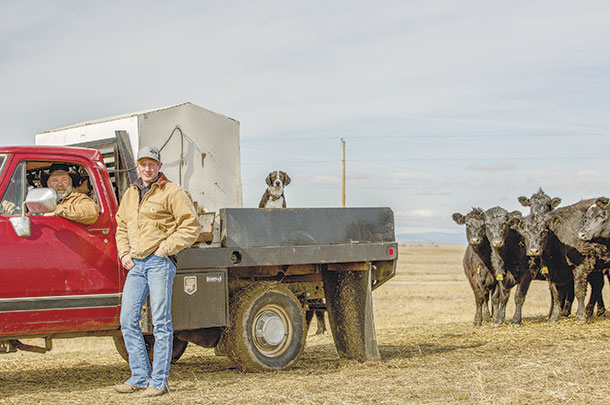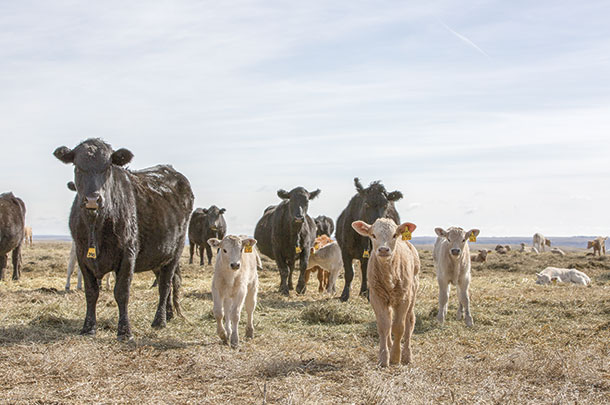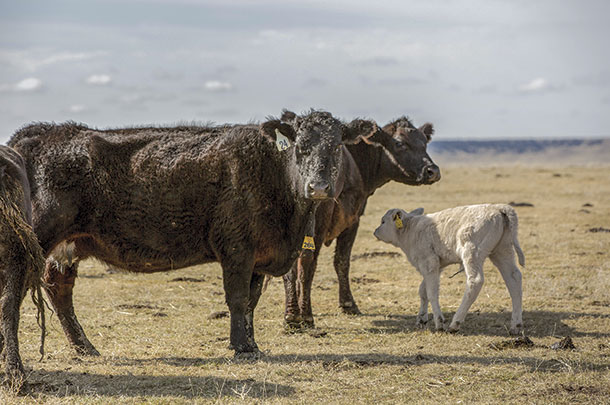Ranching goes back at least seven generations for the Sanders family to a land grant nearly 140 years ago, which was ultimately traded for the ranchland managed today by the fourth and fifth generations at this location in Pennington County.
Extending family roots

The roughly 500-cow commercial herd and 40-cow purebred herd are owned and managed by brothers Mark (Lisa), John (Sue) and Jim (Sheri) Sanders, and there’s hope of this life and livelihood continuing on as John’s son Jeremiah and Mark’s daughter Whitney are primarily involved, with Whitney’s oldest boy, Leedin, taking an interest as well. Beyond that, other family members and friends can be counted on for the big events – like spring branding and fall shipping.
Jeremiah attends Mitchell Technical Institute, a nearly four-hour drive to the eastern side of the state, coming home for work weekends, calving season, shipping season and branding. He is also responsible for the 300 pairs that graze leased land in the Black Hills over summer.
Just starting his second year of the two-year ag program, majoring in animal science, Jeremiah says he is surprised at how much new information he’s learning and appreciates his professor has cattle of her own and has been a veterinarian for 25 years.
“I chose a two-year program over a four-year program for that reason,” says Jeremiah. “I like knowing the people I’m learning from have cattle.”
Last spring, he also started a part-time internship at a sale barn, which gives him a closer relationship to another facet of the beef business.
On this late-winter Sunday morning, he’s out feeding with his uncle Mark as calving season comes to an end.

“We’re breeding much the way Dad wanted them,” Mark explains as we ride along in the pickup trailing cake for the mama cows while hay is brought down with the tractor. The stock are close by from mid-October through mid-May. “We raise our own bulls from 40 purebred Charolais. We use them and prove them, and then sell only what we have used.”
Calf crop dynamics
Groups of calves are frolicking, and piles of them lie in the sun while the cows follow the truck. Mark reports they had 500 calves born during the busiest three weeks from mid-February to the first of March. “We had 37 in one day,” he smiles.
From the purebred Charolais crop, they’ll select 10 bulls each year based on simple criteria: “If I would buy him, he stays a bull. If we don’t use him, then we don’t sell him either (as a bull).”
 Likewise, 10 female Charolais will be retained as replacements for the older cows in the purebred herd. Those not making that cut move into the commercial herd.
Likewise, 10 female Charolais will be retained as replacements for the older cows in the purebred herd. Those not making that cut move into the commercial herd.
The best of the Charolais bulls are used on the Charolais females, and the others are used to produce terminal crosses on the predominantly black commercial cow herd.
The Sanders also keep two Angus bulls, which they buy from the same local breeder and use on their first-calving females to keep their calves on the smaller side.
“That’s the future right there,” says Mark as he points out a newborn purebred Charolais calf with the pedigree to make the top cut.
Prairie grazing
As we look out across the dull bluffs that will soon become more vivid with rain and warmer temperatures, Mark talks about what he’s just put down for the cows.
“We feed a higher-magnesium cake this time of year to set them up for the green grass that’s coming,” he explains. “We like to be sure they get the higher magnesium over the 20 to 30 days prior to green grass. Since we’ve been doing this, we rarely see milk fever and grass tetany. Everything we do here is to set up their immune systems to go with the seasons.”
Running a small herd of buffalo on some of this land, the Sanderses see how it can be for the cattle when they are managed with a more preventive and hands-off approach to match the natural cycles of the land. In both cases, the animals are moved with grass growth to keep the grasslands diverse and regenerating.
The buffalo calve in May and are harvested mainly through hunts. “We enjoy them, and they provide some extra income,” he says. “But we don’t mess with them.”
The buffalo here live free.
“We mostly leave them alone and let them be buffalo, so we don’t change their shape and their smarts,” Mark explains, adding they are largely self-sufficient except for some supplemental hay in the wintertime, especially in dry years.
The buffalo meat is popular with some, but Mark prefers beef: “I like the flavor of that fat on my beef. I’ll choose beef every time.”
He says they approach their cattle breeding and management as close to that natural model as possible.
“Whatever we can prevent results in a stronger animal. If a calf gets sick and we doctor it, and it gets better, it’s going to be weaker the rest of its life. So we try to keep the cattle herd strong,” Mark explains.
The same is true for the land, where a diversity of grasses, stocking densities and movement keep the grasslands healthy and the cattle too.
“This country is rugged but fragile. It can be hurt if we’re not careful,” says Mark. “The ground tells us how we’re doing. It tells us if we’re building soil and diversity or wearing it down.”
Of the native grasses here, the bluestem is what the cattle and buffalo love most. The key, says Mark, is to balance grazing with growth, so forage regenerates and remains diverse. He talks of the balance between overgrazing and undergrazing.
If the grasslands are overgrazed, he says, desirable cool- and warm-season grasses, like the bluestem, will be inhibited more than the less desirable grasses, changing the balance of diversity as well as the nutritional value for the cattle.
Undergrazing, on the other hand, reduces that regenerative stimulation of the most desirable grasses, which means less forage later.
Working side-by-side
Back at the homestead, the family gathers with friends to brand calves the first week of May, and the pairs are turned out May 15 to spend the summer in the rough country, where they derive all of their nutrition from the land. Around June 1, they’ll move 10 semi loads, around 300 pairs, to do grazing management on land they lease from the Forest Service in the Black Hills.
Over the summer, those pairs in the Black Hills are Jeremiah’s responsibility. He’ll spend the whole summer there, mostly doing fencework and moving cattle.
“I like what we do there, and we have a great relationship with the Forest Service because we are looking out for each other, and the system brings benefits for both of us,” says Jeremiah.
The Sanderses are very much realists about what they do.
Jeremiah expresses the philosophy prevalent among the older generation.
“I think it comes down to having hard work to do – and loving it,” he says. “There’s nothing like doing that hard work – like fixing fence – and seeing that it looks good when you’re done.”
The same concept applies to the cattle breeding program.
Those baby calves come fast and furious, and in all kinds of weather, but for the Sanderses, it is satisfying to see those healthy uniform calves basking in the crisp late March prairie sunshine. ![]()
PHOTO 1: “This country is rugged but fragile. It can be hurt if we’re not careful. The ground tells us how we’re doing. It tells us if we’re building soil and diversity or wearing it down.”
PHOTO 2: Mark Sanders and his nephew Jeremiah put out the range cake for the cows on a crisp late March morning. They feed a higher-magnesium cake 20 to 30 days before turnout to prepare them for green grass.
PHOTO 3: Mark Sanders and his brothers John and Jim operate Sanders Ranch. Cattle ranching in western South Dakota goes back seven generations, with five generations in cattle at the ranch where they are today.
PHOTO 4: The Sanderses breed Charolais bulls and have used them on their commercial Angus herd for generations. They believe it is the best terminal cross for producing calves with heavier weaning weights and yearling weights, and mainly for how they function in the feedlot in terms of feed efficiency and lean muscle growth. Photos by Sherry Bunting.
Sherry Bunting is a freelance writer in eastern Pennsylvania.
‘They’ll always be our Virginia girls’
Last October marked the five-year anniversary of Storm Atlas that hit the region in the first week of October 2013 and was the deadliest storm, in terms of cattle and livestock losses, ranchers had ever seen. Some figured the blizzard of 1939 was about the only thing comparable, and most had not been around for that one.
 Sanders Ranch was among the many to deal with substantial cattle losses, a third of the cow herd and almost as many calves along with some of their prized bulls. They were nominated by others to receive bred heifers from the Heifers for South Dakota project that had been founded and organized by Montanan Ty Linger, with the help of many in the region, including Amy Pravacek with Zoetis and Tom Brunner, whose former western South Dakota dairy-turned-custom-cattle-operation became the commingling center for incoming heifers.
Sanders Ranch was among the many to deal with substantial cattle losses, a third of the cow herd and almost as many calves along with some of their prized bulls. They were nominated by others to receive bred heifers from the Heifers for South Dakota project that had been founded and organized by Montanan Ty Linger, with the help of many in the region, including Amy Pravacek with Zoetis and Tom Brunner, whose former western South Dakota dairy-turned-custom-cattle-operation became the commingling center for incoming heifers.
While the 17 bred heifers received by the Sanderses were a small fraction of their losses, those heifers gave the three Sanders brothers and their families something much more important than economic benefit.
The heifers they received came from a load shipped in February 2014 from the members of the Rockingham Feeder Cattle Association. When this group of cattlemen heard of the storm losses, they got busy putting a load of bred heifers together. As a former dairyman-turned-beef producer, Lynn Koontz of Spring Valley Farms, Harrisonburg, Virginia, was confident moving bred heifers ahead of calving. A load of 40 went west in February that year and a load of 60 open heifers by April.
Some of those bred heifers ended up at Sanders Ranch, including a few that – believe it or not – were carrying Charolais-Angus cross calves.
“It was the hope they brought us, the feeling that we’re not alone, that someone as far away as Virginia would donate a top-quality bred heifer to other cattlemen like us here in South Dakota – I can’t even begin to put a number on that,” Mark reflects. “Those heifers and their offspring are special to us, and they will always be known on this ranch as our ‘Virginia girls.’”
Having been to the Sanders Ranch for the May 1 branding that first spring after Atlas, picturing No. 24 from Virginia with her new calf on South Dakota soil, I had to catch my breath when No. 24 emerged from the group of cows on my return visit that Sunday morning nearly five years later.
Hope lives on.
PHOTO: Four years after arriving in South Dakota after Storm Atlas, No. 24 is healthy and delivering offspring. Photo by Sherry Bunting.








